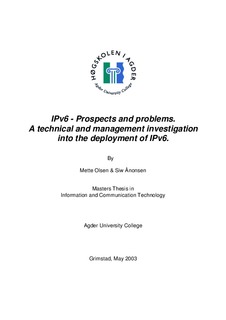IPv6 : prospects and problems : a technical and management investigation into the deployment of IPv6
Master thesis
Permanent lenke
http://hdl.handle.net/11250/137282Utgivelsesdato
2003Metadata
Vis full innførselSamlinger
Sammendrag
IPv4 has been used for over twenty years, and will most likely be used in many years ahead.
However, we are now experiencing that the IPv4 address space is running out, resulting in
restrictions on who will be able to get these types of addresses assigned to them. Methods
such as Network Address Translator (NAT) have been developed and implemented in order to
save the IPv4 address space. It is said that this is not a good enough solution, as such
techniques introduce new problems at the same time solving some.
A new version of the Internet Protocol, IPv6, has been developed and is likely to replace
IPv4. IPv6 has been developed to solve the address problem, but also new features are
designed to supposedly enhance network traffic.
In our thesis we give an overview of the problems with IPv4. This includes the limited
address space and the limited quality of service. Further we present the features of IPv6 that
are meant to solve these problems and add new possibilities. These are: New address format,
the IPv6 header and Extension headers to mention some.
Further we have investigated and here present how the transition from IPv4 to IPv6 is
expected to take place, followed by a thorough description of the transition mechanisms. One
of the original intentions on the development of IPv6 was that IPv4 and IPv6 have to be able
to coexist for a long period of time. Transition mechanisms have therefore been designed to
make this possible. There are three main types of mechanisms:
- Tunnelling
- Translation
- Dual-stack.
Each of these mechanisms requires different configuration and implementations in hosts and
network.
Technical research on transition mechanisms states that these are not good enough for all
IPv6/IPv4 scenarios and need improvements in order to make IPv4 and IPv6 coexist
smoothly. There are a lot of transition mechanisms that are agreed upon as being good for
general use and then there are transition mechanisms that are good for certain scenarios and
not for others. Some scenarios still lack a good translation mechanism. As a result of this,
IPv6 networks are being built separately from IPv4 networks. In Asia commercial IPv6
networks are offered, while the process is slower in other parts of the world. The reasons for
not building IPv6 networks are many, and not agreed upon. Some believe it is because of
economical restrictions, while others claim it is technical reasons and that it exists far too few
applications supporting IPv6. The number of IPv6 enabled applications is growing. Large
companies like; Microsoft Corporation, Cisco Systems Inc, Apple Computers Inc., Sun
Microsystems Inc and various versions of Linux include support for IPv6.
The deployment of IPv6 is expected to happen at different times in different parts of the
world. We have investigated the status of IPv6 globally and in Norway. The main results are that the roll-out has reached the furthest in Asia where commercial IPv6 networks already are
offered. The activity in Norway is still small, but growing.
It was desired to run an experiment in order to prove or disprove some of the information we
gathered on how IPv6 interoperates with IPv4, but because of limitations in the network at
Heriot-Watt University we were not able to do this. Instead we have focused on a project by
Telenor R&D; “IPv6 migration of unmanaged networks-The Tromsø IPv6 Pilot”. We also
gathered some information from people working at Norwegian ISPs in order to address some
of the aspects of the upgrading.
Beskrivelse
Masteroppgave i informasjons- og kommunikasjonsteknologi 2003 - Høgskolen i Agder, Grimstad
Utgiver
Høgskolen i AgderAgder University College
